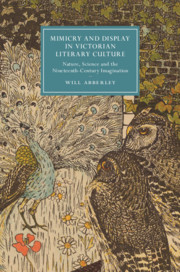 Mimicry and Display in Victorian Literary Culture
Mimicry and Display in Victorian Literary Culture Book contents
- Mimicry and Display in Victorian Literary Culture
- Cambridge Studies in Nineteenth-Century
- Mimicry and Display in Victorian Literary Culture
- Copyright page
- Contents
- Figures
- Acknowledgements
- Introduction
- Chapter 1 Seeing Things
- Chapter 2 Divine Displays
- Chapter 3 Criminal Chameleons
- Chapter 4 Darwin’s Little Ironies
- Chapter 5 Blending in and Standing out, I
- Chapter 6 Blending in and Standing out, II
- Conclusion
- Notes
- Bibliography
- Index
- Cambridge Studies in Nineteenth-Century Literature and Culture
Conclusion
Adaptive Appearance and Cultural Theory
Published online by Cambridge University Press: 16 May 2020
- Mimicry and Display in Victorian Literary Culture
- Cambridge Studies in Nineteenth-Century
- Mimicry and Display in Victorian Literary Culture
- Copyright page
- Contents
- Figures
- Acknowledgements
- Introduction
- Chapter 1 Seeing Things
- Chapter 2 Divine Displays
- Chapter 3 Criminal Chameleons
- Chapter 4 Darwin’s Little Ironies
- Chapter 5 Blending in and Standing out, I
- Chapter 6 Blending in and Standing out, II
- Conclusion
- Notes
- Bibliography
- Index
- Cambridge Studies in Nineteenth-Century Literature and Culture
Summary
The Conclusion reflects on the implications of the study’s findings for future research, particularly in cultural theory. Victorian adaptive appearance is considered as a discourse that in certain ways prefigured the works of Charles Sanders Peirce and Jakob von Uexküll, and more recent theorisations of biosemiotics and zoosemiotics. The study shows that contemporary concepts of non-human and cross-species semiosis are less new than they may seem. However, it also problematises post-humanist celebrations of the supposed collapsing of the human/non-human binary. Similarly, the study shows that biosemiotic thinking does not necessarily align with progressive politics, as is sometimes assumed. As a cultural trope, adaptive appearance could both undermine and reinforce essentialist views of identity. It is suggested that the study’s discussions of visibility, recognition and appearance signpost new ways of approaching the politics of the gaze and the ideological stakes of female visibility. Some hints are offered on how researchers might explore the afterlives of adaptive appearance in twentieth-century science and culture. The chapter also notes how adaptive appearance has featured in retrospective fictive depictions of Victorian society and culture. Finally, parallels are suggested between Victorian adaptive appearance and current representations of environmental crisis.
- Type
- Chapter
- Information
- Mimicry and Display in Victorian Literary CultureNature, Science and the Nineteenth-Century Imagination, pp. 205 - 214Publisher: Cambridge University PressPrint publication year: 2020
